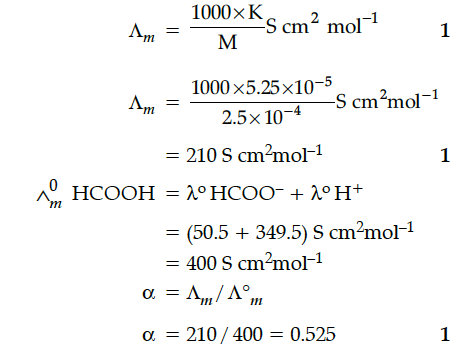Calculate the molar conductivity and degree of dissociation.
Conductivity of 2.5 × 10⁻⁴M methanoic acid is 5.25 × 10⁻⁵ Scm⁻¹.
Given : = 50.5Scm² mol⁻¹
Conductivity of 2.5 × 10⁻⁴M methanoic acid is 5.25 × 10⁻⁵ Scm⁻¹.
Given : = 50.5Scm² mol⁻¹

Calculate the degree of dissociation (α) of acetic acid if its molar conductivity () is 39.05 Scm² mol⁻¹. Given (H⁺) = 349.6 Scm² mol⁻¹ and (CH₃COO⁻) = 40.9 Scm² mol⁻¹..
The molar conductivity of 0.025 mol L⁻¹ methanoic acid is 46.1 S cm² mol⁻¹. Calculate its degree of dissociation and dissociation constant. Given λ°(H⁺) = 349.6 S cm² mol⁻¹ and λ°(HCOO⁻) = 54.6 S cm² mol⁻¹.
The conductivity of a 0.01 M solution of acetic acid at 298 K is 1.65 x 10⁻⁴ S cm⁻¹. Calculate molar conductivity () of the solution.
The conductivity of 0.20 M solution of KCl at 298 K is 0.025 Scm⁻¹. Calculate its molar conductivity.
How is electrical conductance of a conductor related with length and area of cross-section of the conductor?
a. G = \(l. a.k^{-1}\)
b. G = \(k. l.a^{-1}\)
c. G = \(k.a. l^{-1}\)
d. G = \(k. l.a^{-2}\)
(i) State the law which helps to determine the limiting molar conductivity of weak electrolyte.
(ii) Calculate limiting molar conductivity of CaSO₄ (limiting molar conductivity of calcium and sulphate ions are 119.0 and 160.0 Scm² mol⁻¹ respectively)
Consider the standard electrode potential values (M²⁺/M) of the elements of the first transition series.
(a) Calculate G° for the reaction
Zn(s) + \(Cu^{2+}\)(aq) → \(Zn^{2+}\)(aq) + Cu(s)
Given: E° for \(Zn^{2+}\)/Zn = -0.76V and E° for \(Cu^{2+}\)/Cu = +0.34 V
R = 8.314 \(JK^{–1}\) \(mol^{–1}\), F = 96500 \(mol^{–1}\)
Out of the following pairs, predict with reason which pair will allow greater conduction of electricity:
(i) Silver wire at 30°C or silver wire at 60°C.
(ii) 0.1 M \(CH_3\)COOH solution or 1 M \(CH_3\)COOH solution.
(iii) KCl solution at 20°C or KCl solution at 50°C.
When a certain conductance cell was filled with 0.1 M KCl, it has a resistance of 85 ohm at 25°C. When the same cell was filled with an aqueous solution of 0.052 M unknown electrolyte, the resistance was 96 ohms. Calculate the molar conductance of the electrolyte at this concentration.
[Specific conductance of 0.1 M KCl = 1.29 × 10⁻² ohm⁻¹ cm⁻¹]
Write the preparation of following :
(i) KMnO₄ from K₂MnO₄
(ii) Na₂CrO₄ from FeCr₂O₄
(iii) Cr₂O₇²⁻ from CrO₄²⁻
Give reasons :
(i) Mn shows the highest oxidation state of +7 with oxygen but with fluorine it shows the highest oxidation state of +4.
(ii) Transition metals show variable oxidation states.
(iii) Actinoids show irregularities in their electronic configurations.
Calculate the molar conductivity and degree of dissociation.
Conductivity of 2.5 × 10⁻⁴M methanoic acid is 5.25 × 10⁻⁵ Scm⁻¹.
Given : = 50.5Scm² mol⁻¹
